Right to repair draft report
Speech
Commissioner Paul Lindwall delivered a speech to the Australian Repair Summit in Canberra on 9 July 2021.
Download the speech
Read the speech
Thanks – it’s great to be here at the Repair Summit and I’m glad that Leanne has organised the day. We are well represented from the PC (including fellow commissioner Julie Abramson up from Melbourne and my Canberra colleagues Aaron, Paulene, Caroline, Sophie and Max – and colleagues online from Melbourne: Paul (now team leader), Roger, Bonnie, James and Holly). I also acknowledge the tremendous work of team leader Ana Markulev who had two deliveries: the draft report and then a baby.
The Right to Repair inquiry has been fascinating, with many dimensions to the topic. We released our draft report on 11 June and are inviting submissions in response to the draft by 23 July. We are also holding public hearings later in July.
We will send the final report to the Government by 29 October and it has up to 25 sitting days to table the report. The Government then decides whether or not to accept our recommendations.
In the draft report we pose some initial views and outline where we do not yet have sufficient evidence to make a call. The latter form information requests and we also expect to hold some roundtables to discuss specific areas of the report. Most of the draft recommendations can be characterised as ‘no regrets’ policies – those that are worth pursuing in any case.
If I could summarise the concerns that led to our inquiry, they would be this:
- it has become increasingly difficult and expensive to effect a repair on a broken product and there is a lock in to ‘authorised repairers’
- spare parts are not available
- products are not designed to last and fail early and consumers tend to buy new products rather than have their old products repaired
- there has been a proliferation of e-waste.
But these are broad generalisations and don’t always apply. In this inquiry we have examined the evidence from submissions and our own research, and we have also looked at the experience and policies implemented overseas.
What is a ‘right to repair’? There are a lot of definitions floating around, but for the purposes of our inquiry we have settled on this:
A right to repair is the ability of consumers to have their products repaired at a competitive price, by the repairer of their choice.
Note this does not mean that a consumer has the right to have a product repaired at any cost. We need to balance competing interests – those of consumers, manufacturers, retailers and governments.
For example, if my halogen light failed it would be prohibitively expensive to have it repaired rather than buy a replacement LED light.
In this report we have examined policies across a range of areas:
- Product obsolescence and design standards
- Consumer law
- Competition in repair markets
- Intellectual property
- e-waste management.
I want to touch on these today and there will be an opportunity to ask questions.
Product design and obsolescence
Why do some products last many years, while others break quickly? Some are easy to repair, others virtually impossible.
The cars in Cuba many dating to the 1940s, are lovingly maintained by their owners, often family heirlooms. As you travel around Cuba, you’ll see men hunched over cars, repairing engines and fixing exhaust systems.
Since the country lacks replacement parts, the locals are extremely crafty and adept in their repairs. Cuban ingenuity has kept these old cars on the road. Mechanics find ways to use imperfect parts and keep the things running.
In Australia, the CEO of the NRMA, Rohan Lund, recently wrote:
“Australians are notoriously slow at upgrading the family car – at 10 years, the average age of our cars is second oldest in the developed world”
But shouldn’t we be proud of this? Is it better that consumers switch over their cars in less than 10 years? We expect a washing machine to give more than ten years’ service and yet a car should be less than 10 years?
We replace products for a whole range of reasons. It could be the product is broken and it’s more expensive to repair than replace. It could be that a new product offers features that we desire, or the new product is more efficient and less environmentally harmful. It could be that we like a change for the sake of fashion.
The design of many products today has incorporated solid state technology, including the internet of things, allowing our products to be connected and controlled remotely. This has been an important factor leading to the rapid change over of certain products.
But why do Pont du Gard and the Pyramids of Giza stand after so many thousands of years? It’s because they were built by trial and error – over engineered if you will. The Roman bridges and Egyptian pyramids that were not so well constructed have collapsed long ago.
Today we can design products very precisely, using the minimum materials needed for the particular product. The products are then made in a factory in very consistent and predictable ways. This has led to an increase in the mean time between failures (MTBF) of well designed and built products and also a narrowing in the variation of the MTBF.
Yes, products fail and break. But frequently they are becoming replaced because of continuing rapid technological innovation. We the consumer are replacing our products before they fail.
Do we replace products needlessly? Yes, and I’m as guilty of that as are many of us. Am I brainwashed into buying the new phone? No. It’s my choice.
Overall we didn’t find clear evidence that manufacturers deliberately design products to fail early.
But perhaps there might be merit in some labelling scheme to help consumers understand how easy it is for their product to be repaired and its durability. France has such a labelling scheme and we are investigating this further for the final report.
Consumer law
Australian consumer law (ACL) provides extensive and comprehensive guarantees. But the guarantees are not well understood and they can be difficult and costly to enforce.
It is important to separate the manufacturer’s warranty from a consumer guarantee under Australian consumer law. Warranties cannot supplant consumer guarantees.
The rights a consumer has under the guarantees are for a repair, replacement or refund depending on the nature of the failure. The ACL provides that a product will have ‘reasonable durability’ but doesn’t define what that means. This leaves consumers, manufacturers and retailers being unsure and can cause confusion. In 2019-20, the ACCC reported over 37,600 complaints about consumer guarantees and warranties.
So we think there is scope to improve the understanding of consumer guarantees and make it easier for consumers to enforce their rights. So we have three draft recommendations that we expect will help.
First, we think the ACCC should develop and publish estimates of the minimum expected durability of products within major categories of common household products. We expect this would help consumers, retailers and manufacturers better understand what a reasonable durability for such products might be. We also think that the ACCC should develop this guidance in consultation with relevant State and Territory consumer regulators, consumer groups and business groups.
Second, we think there is scope for an extension of alternative dispute resolution (ADR) schemes to better resolve complaints and we cite two examples, one from South Australia and the other from NSW. ADRs can help consumers enforce their rights without the expense of going to Court.
Third, for systemic issues we think a super-complaints system which allows complaints from recognised consumer groups to be made to the ACCC and for these to be fast tracked and responded to by the ACCC will help where an issue is of widespread concern.
Additionally, we have received many submissions that express concern about the availability of spare parts and software/firmware updates. We are inviting further evidence to inform just how far we should go and whether there would be a net benefit in mandating manufacturers to hold spare parts for minimum periods as well as whether software updates be provided by manufacturers for a reasonable period of time after the product has been purchased.
Holding spare parts is costly, so is providing software updates for products no longer manufactured. But so too is it costly when a product cannot be repaired for the sake of one spare part.
It’s a balance and that’s why we are asking for more evidence.
As an aside, the increasing use of 3D printing may provide a less costly way of providing spare parts in the future – just as we now see print on demand for rarely purchased books.
Competition in repair markets
In 2018 there were about 57,000 repair and maintenance businesses and over 203,000 workers. The repair sector generated about $35 billion in sales revenue.
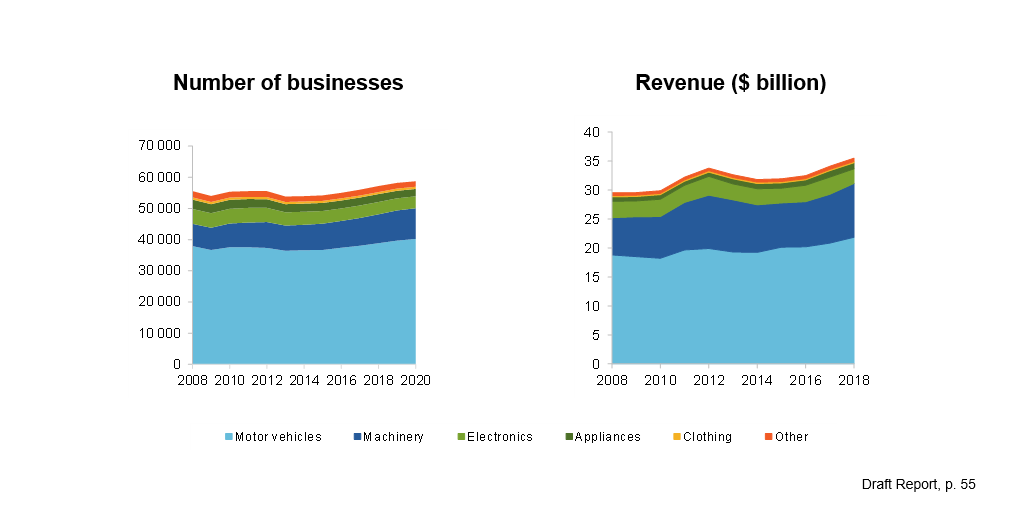
It’s probably not surprising that the largest repair industry in Australia is for motor vehicles. There were 40,000 of them in 2020. They are large, expensive and complex mechanical and computerised products requiring regular maintenance.
The next largest repair industry is machinery repair, including for agricultural, construction and mining machinery of which there were around 10,000 repairer businesses.
Appliance repair – such as for washing machines, ovens, air-conditioning units, water heaters, etc – comprises mostly of small businesses. It has experienced relatively strong growth over the past ten years, but also consolidation.
Finally the electronics repair industry – for computers, mobile phones etc – is a small part of the sector and has been declining probably due to the relative cost of repair to replacement.
So that is the repair sector – a mixture of independent and ‘authorised’ repairers. And a common refrain to this inquiry has been the efforts by manufacturers and retailers to send customers to their authorised repairers and to make it difficult for independent repairers.
In the report we discuss the interactions between competition in the primary market – the original product purchase – and in the secondary market – the repair market. A highly competitive primary market can mitigate the negative effects of an uncompetitive secondary market.
That said, there are several products for which market characteristics, including high consumer lock-in and limited product competition, may mean that competition in those repair markets is limited. For the draft we identified agricultural machinery and mobile phones and tablets as products where there is likely to be consumer detriment.
We also looked at concerns in the repair markets for motor vehicles, construction machinery, watches and medical equipment.
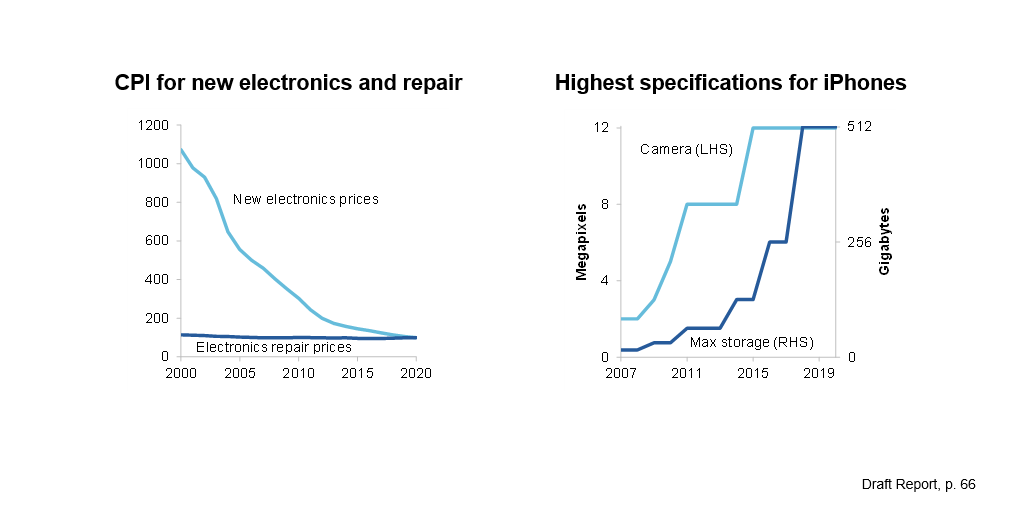
The cost of repair is driven largely by labour costs, and this is one reason that many products are often less expensive to replace than to repair, although examples of the difficulty in replacing the screens and batteries of smart phones are manifold.
These design features – making repair difficult – are not unique to Australia as we are an importer of most of this technology. That said, we are looking at the potential for labelling schemes as I mentioned before that exist in France.
The labour-intensive nature of repair is such that the relative price of new electronics (produced in mass in a capital-intensive factory) has fallen rapidly in real terms while repair costs have grown with labour costs.
Aside from potential labelling schemes, there are a number of measures which we propose and wish to examine further to promote competition in the repair sector.
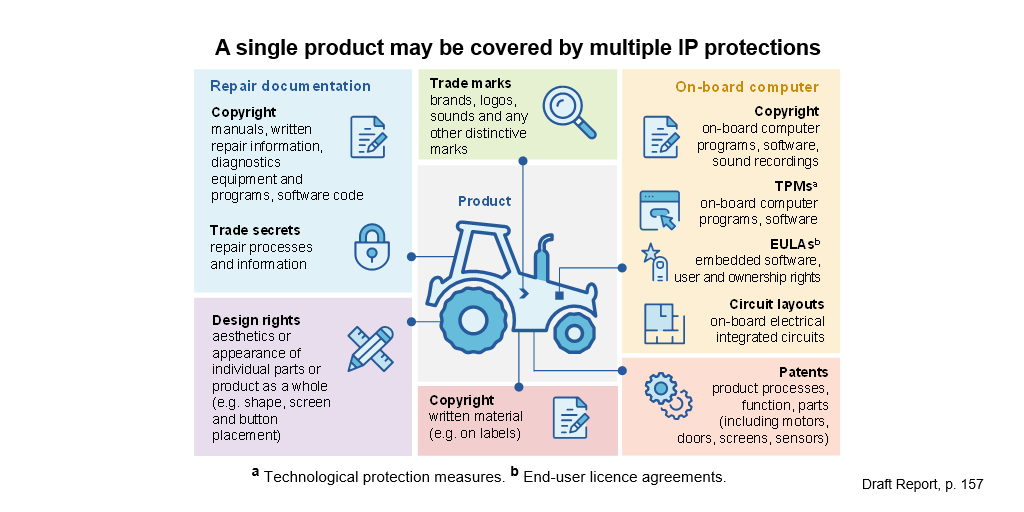
First, should we amend copyright law to provide better access to repair information (manuals, schematics, and diagnostic information) which can often be hidden behind TPMs (technological protection measures such as digital locks)? This could be achieved via a specific copyright exemption for the reproduction and sharing of information in a fair dealing exception in the Copyright Act.
Or it could be through a general copyright exemption via a broad fair use exception in the Copyright Act, something we recommended in the 2016 Intellectual Property Arrangements inquiry report. It’s notable that the United States has a fair use exception to its copyright laws.
And where repair information is hidden behind a TPM, would allowing repairers to distribute and share tools to circumvent such measures to access repair information be beneficial?
A step beyond such intellectual property options would be a positive obligation on a manufacturer to supply spare parts, diagnostic equipment and repair manuals to independent repairers. And if so, to which products should such an obligation apply?
We don’t make a recommendation on such copyright and positive obligation options in the draft report because we need to ascertain that there would be a net benefit from doing so – we need to examine potential unintended consequences and the effects of such proposals on the primary and secondary markets.
Warranty terms
Under Australian consumer law, the consumer guarantees are not voided if a consumer has had their product repaired by an independent repairer. However, manufacturer warranties can include terms that void the warranty after any independent repairs, or if aftermarket parts are used. We examined a number of warranties and found several examples of these voiding clauses. But warranty terms cannot displace the consumer guarantees.
To make this clearer for consumers, we have recommended that there be additional mandatory warranty text which clearly states that the entitlements to consumer guarantees under the consumer law do not require consumers to use authorised repair services or parts.
A step beyond which we canvass but do not yet recommend is whether a provision such as the US Magnuson-Moss Warranty Act should apply in Australia. That is, manufacturers would not be able to void warranties if a consumer used an independent repairer.
E-waste
E-waste is a growing problem in Australia as elsewhere as more and more products use electronic components. Its share of total waste is less than 1% at present, but over the past ten years the weight of e-waste has grown 131% compared to 41% for general waste.
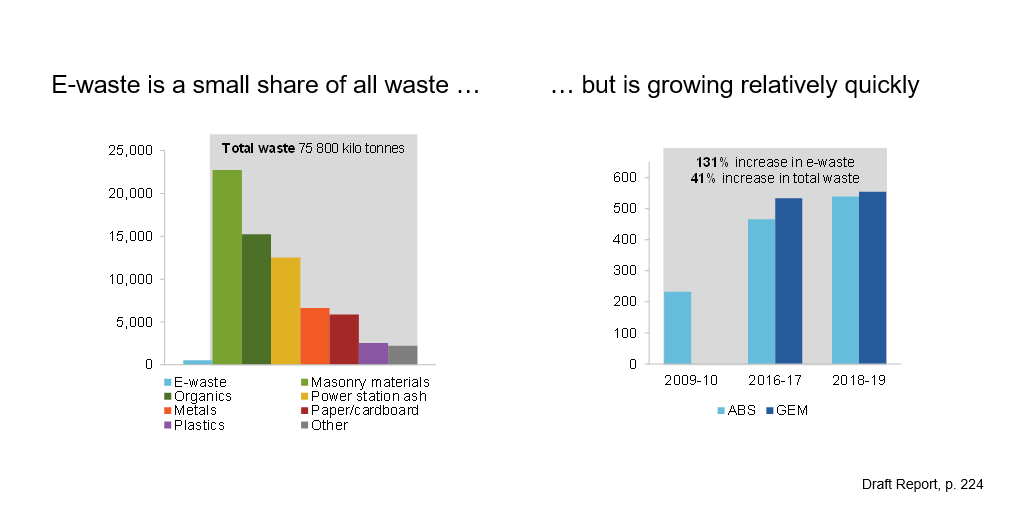
E-waste consists of many materials, some of which is valuable, and some hazardous. The range of materials changes over time, however, as product design and regulations change. Fluorocarbons found in fridges and air conditioners, for example, have been phased out. And the products which presently make up most e-waste include such things as CRT televisions which are no longer manufactured. Sustainability Victoria forecasts that solar panels will comprise around 10% of e-waste in 2035, up from less than 1 per cent in 2015.
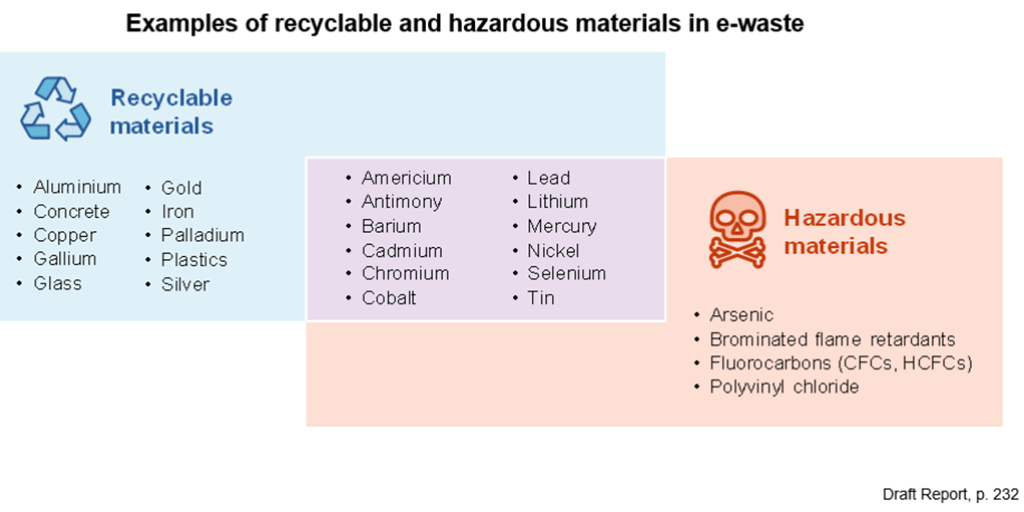
While Australia’s landfill management practices are generally effective, clearly if materials which would otherwise end up in landfill are able to be efficiently reused or recycled than they should be.
A product stewardship scheme – where a manufacturer or importer takes responsibility for the waste from its products – is one way to reduce e-waste.
But a feature of such schemes – such as the National Television and Computer Recycling Scheme – is that they tend to incentivise recycling over repair and reuse. We think that there should be a change to that scheme so that e-waste products that have been repaired or reused count towards the scheme targets. There will need to be design changes of course (and perhaps a name change) and it would be important to have a good scheme design to prevent rorting.
Australia has a relatively small population with limited e-waste recycling capacity because of its dispersed population and high labour costs. So the scope for large-scale, efficient recycling in Australia is limited. The lack of cost-effective domestic recycling can increase the incentives to stockpile, dump or unlawfully export e-waste.
Exporting of e-waste is not problematic provided it is to destinations that efficiently and safely recycle the waste. Australia is a signatory to the Basel Convention on the Control of Transboundary Movements of Hazardous Wastes and their Disposal but not yet the Basel Ban Amendment of 1995 which prohibits signatory states from exporting hazardous waste to any country not in the OECD or EU.
We are recommending the use of GPS trackers – which are relatively low cost – and can be used to see where e-waste is ending up. A risk-based sampling approach would be a useful method focusing on the types of products and supply chains that have the highest risk of unlawful exports.
Conclusion
In this draft report, the Commission has sought to address concerns around a right to repair from a number of angles. There is no silver bullet, however, nor will a right to repair solve by itself e-waste concerns. But there are measures which we are proposing and which we are examining further for the final report that would make a measurable improvement to concerns around sustainability. But it also behoves all of us as consumers to be aware of our patterns of consumption.
I’m not a fan of buy now and pay later schemes, which is a form of instant gratification. Perhaps further consumer education campaigns might help, but our own behaviour as consumers should be one that sets a good example.
As for the ubiquitous smartphone, did you know that according to a US survey 46% of those surveyed (over 18 years of age) used their phones 5 to 6 hours a day. Taking the median, that’s over 2000 hours in a year. That’s a lot more usage than pretty much every other product you have. Your washing machine? Perhaps 150 hours a year. Your car? Perhaps 100 hours a year. So if your smartphone lasts four years, that 8000 hours of use. There are only 8760 hours in a year!
Thanks for listening and contributing to the PC’s inquiry.